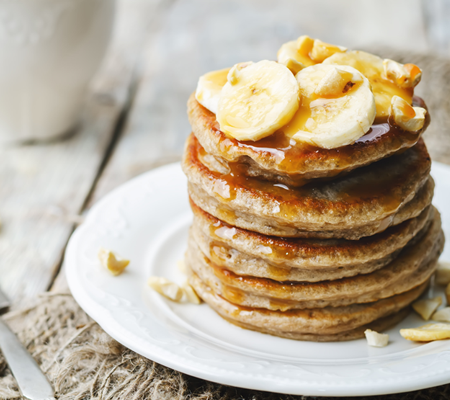
Get the griddle out because it’s time for pancakes. They’re good any day, any time, any way.
Marshfield Clinic Health System Dietitian Chrisanne Urban took a look at this food that’s been eaten for millennia, when they were first made of a “flour” of ground cattails and ferns, mixed with water and cooked on a greased rock. “Everything has to start somewhere but this took all the fun away!” she said.
As pancakes evolved, they were made with a more conventional flour but no leavening agent so they were more like crepes. A leavening agent like baking power was then introduced which made them the high-rising fluffy ‘cake’ with which we’re more familiar.
The first known American cookbook, “American Cookery” published in 1796, included a recipe for pancakes, Urban said. As time went on, there were johnnycakes made with cornmeal, hotcakes, griddle cakes, flapjacks, potato pancakes, hoe cakes, buttermilk pancakes and many variations worldwide with syrups, fruits and other ingredients.
Pancakes made their mark with Shrove Tuesday, the day before Ash Wednesday. That’s when eggs, butter and fat are supposed to be used up to ensure those ingredients would be gone in time for Lent.
Why are pancakes so good?
The answer is simple.
“It’s the butter, of course, and you’re adding sugar and syrup,” Urban said. “They’re usually made with white flour, too, and they absorb fat and sugar.”
To make them healthier, other types of flour have been used that contain more fiber and nutrition, she said.
Can they really be healthier?
Keeping portion sizes smaller helps, as well as not bathing them in butter and syrup, Urban said, or cream cheese and jam. Add whole grain flour to the batter if you have it in your pantry.
Urban has frozen fruit available at all times and fresh fruit like raspberries and strawberries, so instead of syrup she uses fruit as the sweetener, gently heating and then putting it on the cakes.
Another question: “Do you really need butter?” Urban mentions this since it’s the quantity of butter we use that can make them not so healthy.
Another option is buying low-sugar syrup, “but there’s no substitute for real maple syrup,” she said.
You also may want to try making protein pancakes, with recipes that call for a greater variety of healthier ingredients.
For more fun facts about pancakes, click on this link and then try this pancake recipe the next time you’re in the mood for a pancake.
Protein Pancakes
Prep/total time: 15 minutes
Servings: 7
Ingredients
- 1-1/3 cups old-fashioned rolled oats
- 1 teaspoon baking powder
- 1/2 cup cottage cheese
- 2 large eggs
- 1/2 cup water
- 1 teaspoon olive oil
- 1 teaspoon vanilla extract
- dash of cinnamon
Instructions
Add oats and baking powder to a food processor or blender and blend until they’re as fine as flour. Remove to a bowl.
Add the cottage cheese, eggs, water, vanilla, oil and cinnamon to the blender and blend until smooth.
Add the wet ingredients to the bowl with the dry ingredients and stir to combine.
Scoop about 1/4 cup of batter for each pancake and pour onto a hot griddle sprayed with non-stick cooking spray.
Cook on one side until bubbles begin to appear on the surface of the pancake. Flip and cook on the other side until golden.
Serve with fresh fruit and real maple syrup, or a low sugar syrup.
Makes about seven 4” pancakes.
Nutrition information
1 pancake, 100 calories, 11 g carbohydrates, 5 g protein, 3 g fat, 55 mg cholesterol, 77 mg sodium, 148 mg potassium, 1 g fiber, 100IU vitamin A, 53 mg calcium and 1 mg iron.
Source: tastesbetterfromscratch.com
Print recipe





Leave a Reply